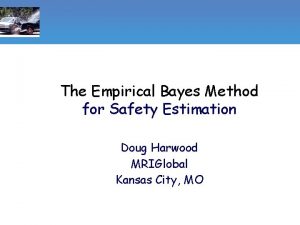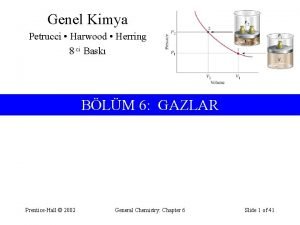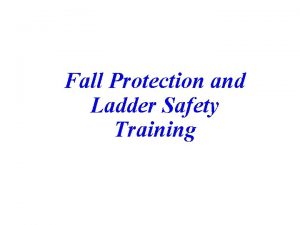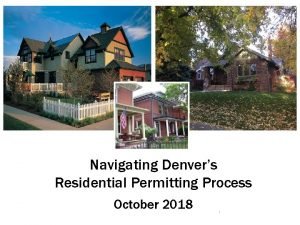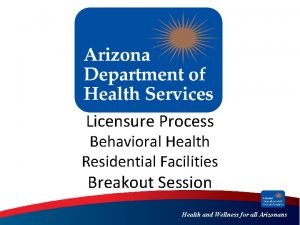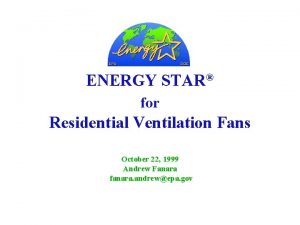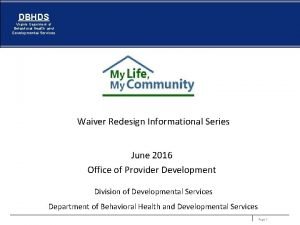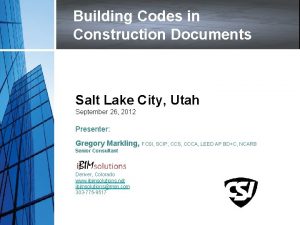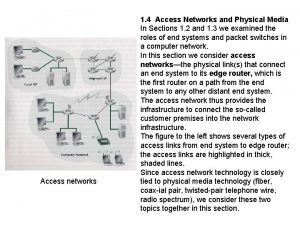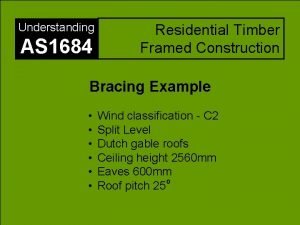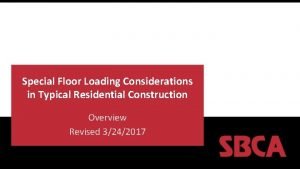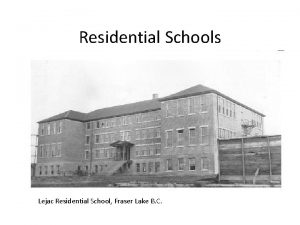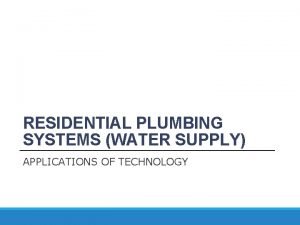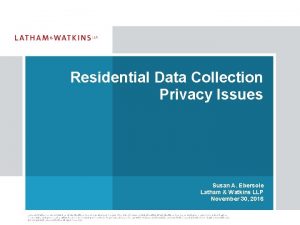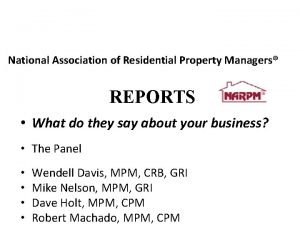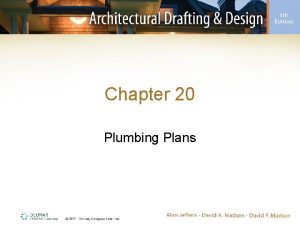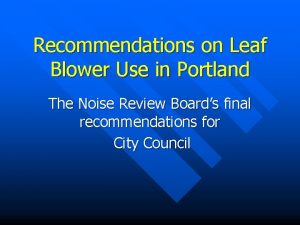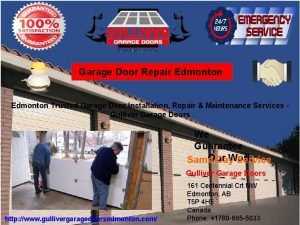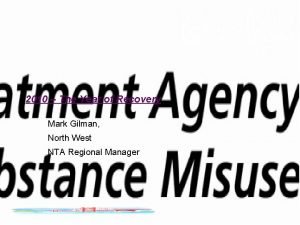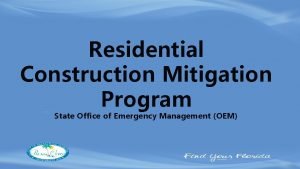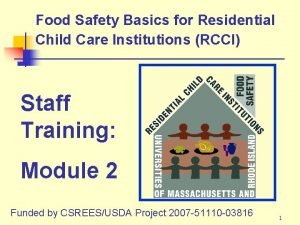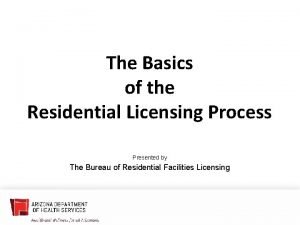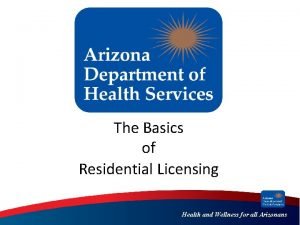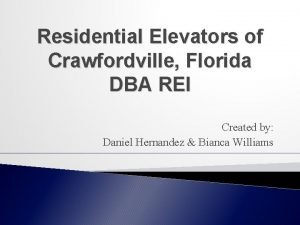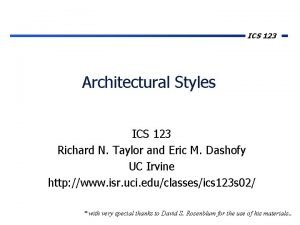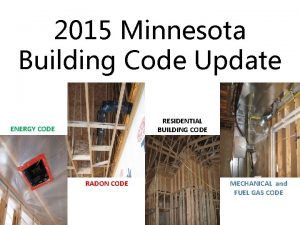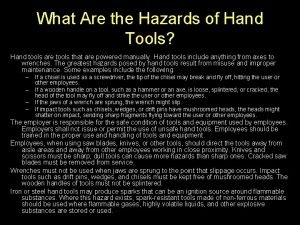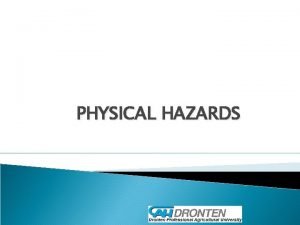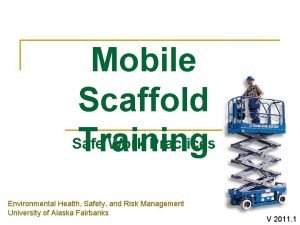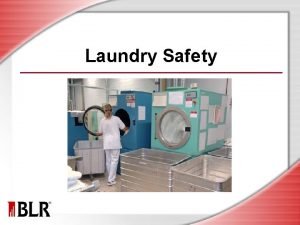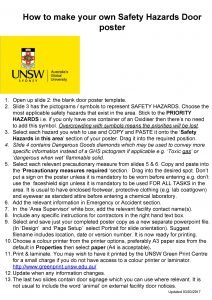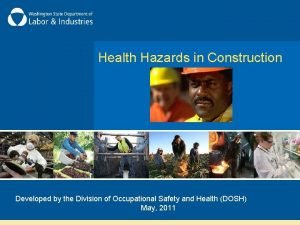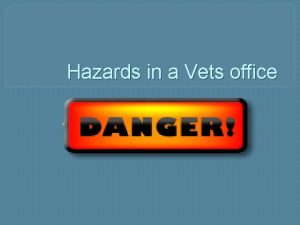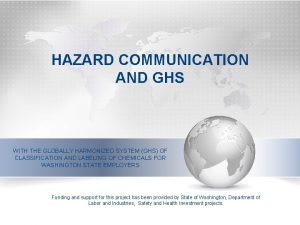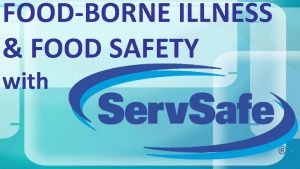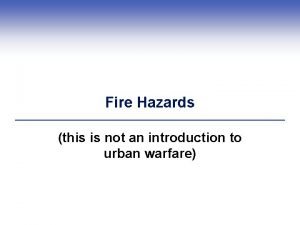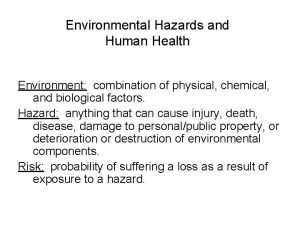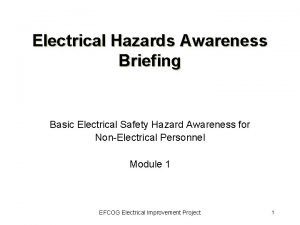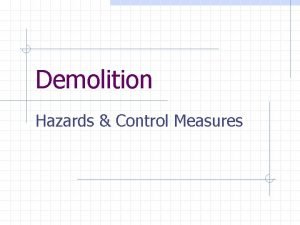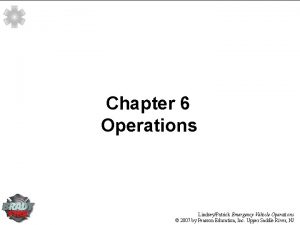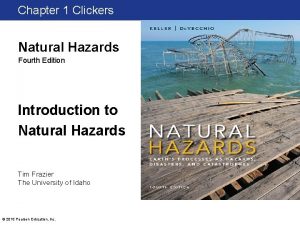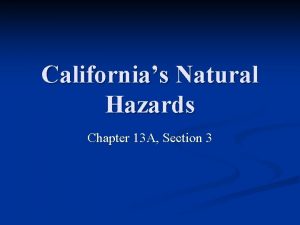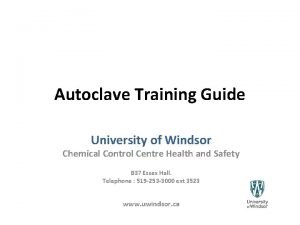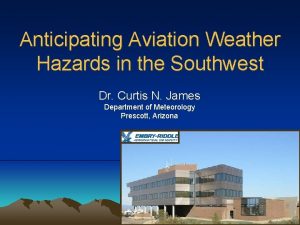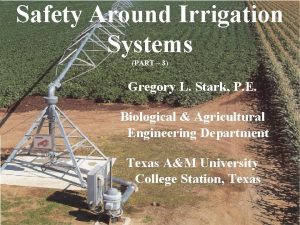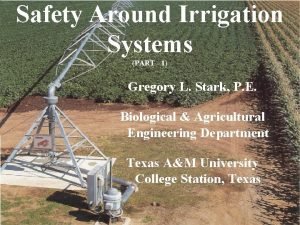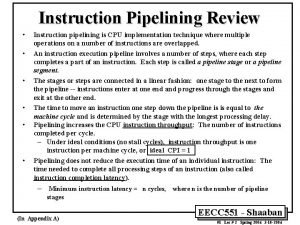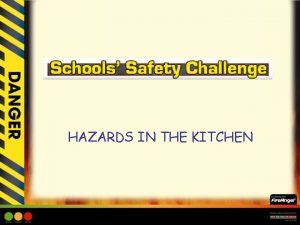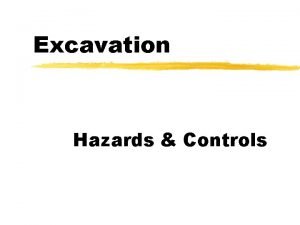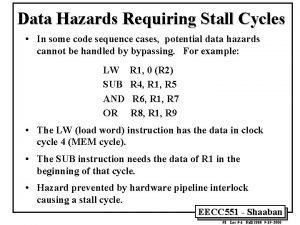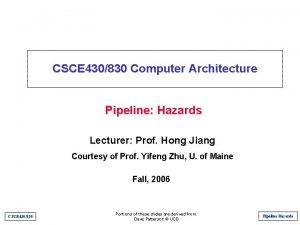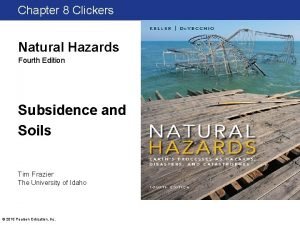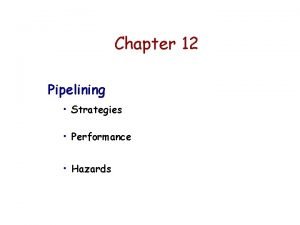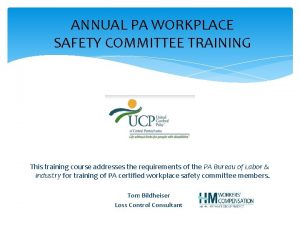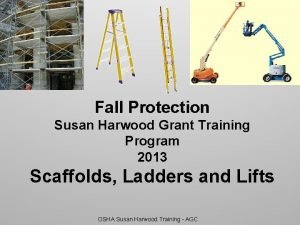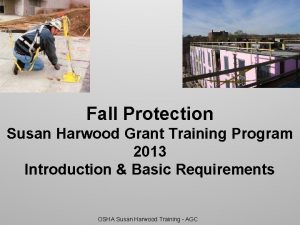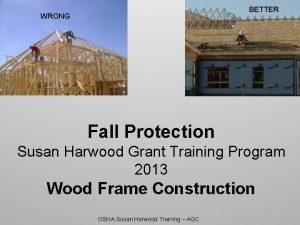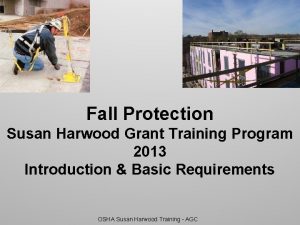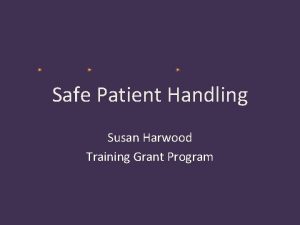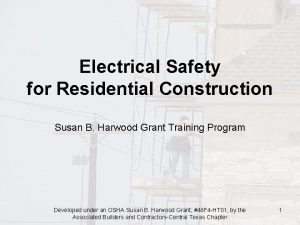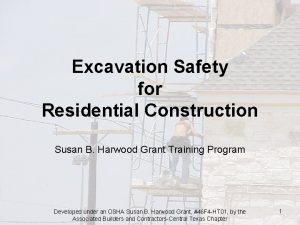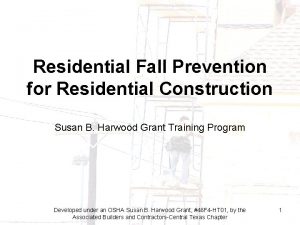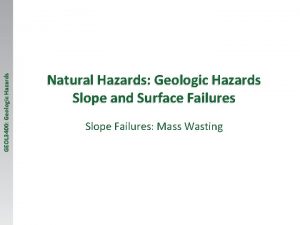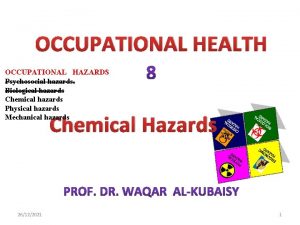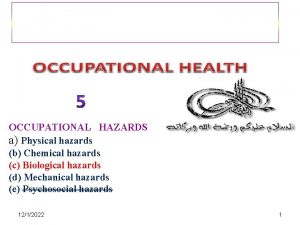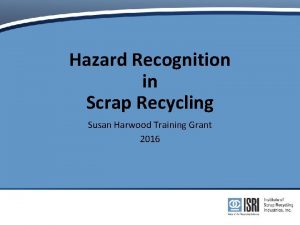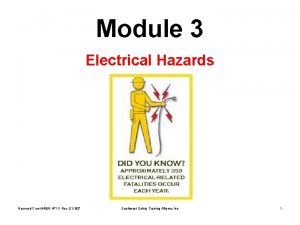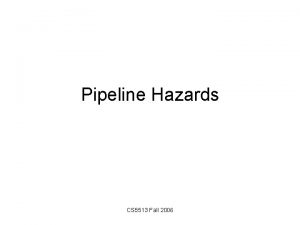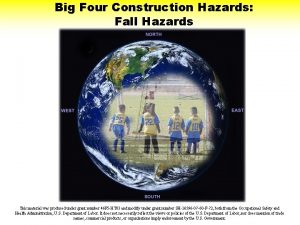RESIDENTIAL FALL HAZARDS Susan Harwood Training Grant 1


















































































































- Slides: 114

RESIDENTIAL FALL HAZARDS Susan Harwood Training Grant 1

Susan Harwood Training Grant This material was produced under grant number SH-22248 -11 from the Occupational Safety and Health Administration, U. S. Department of Labor. It does not necessarily reflect the views or policies of the U. S. Department of Labor, nor does mention of trade names, commercial products, or organizations imply endorsement by the U. S. Government. 2

Residential Construction Fall Hazards All sites have unprotected sides and edges, wall openings, or floor holes at some point during construction. 3

Residential Construction Fall Hazards Each employee on walking/working surfaces shall be protected from falling through holes 4

Residential Construction Fall Hazards These workers are installing a floor joist to a header. Both workers are exposed to a fall of 6 feet or more without fall protection 5

Residential Construction Fall Hazards This worker is standing on the top plate to set a roof rafter. The worker is exposed to an interior and exterior fall hazard. 6

Residential Construction Fall Hazards Each employee on walking/working surfaces shall be protected from falling through openings 7

What you will learn • The worker will be able to identify fall hazards on residential construction worksites • The worker will be able to identify corrective actions for fall hazards during different phases of construction • The worker will be able to use this resource to recognize best, safe work practices 8

Course Overview • Intent of this course – Prevent falls through a focus on safe work practices – Identify fall hazards present during each phase of construction – Identify techniques and the equipment necessary to work safely on residential construction sites when exposed to fall hazards. 9

Course Overview • What this course is not intended to do – Replace worksite specific, fall hazard training on your current and future worksites – Address all fall hazards on your current and future worksites – Address all types of fall protection that you will be using on the worksite 10

“We cannot tolerate workers getting killed in residential construction when effective means are readily available to prevent those deaths. ” “Fatalities from falls are the number one cause of workplace deaths in construction. ” Dr. David Michaels, Assistant Secretary of Labor for OSHA 11

http: //www. osha. gov/dts/vtools/construction/reroofing_fnl_eng_web. html 12

Residential Fall Protection Requirements Effective September 15, 2012, employers utilizing alternative fall protection found in the rescinded 1999 Interim Fall Protection Compliance Guidelines for Residential Construction will be subject to OSHA citations if they fail to comply with 29 CFR 1926. 501(b)(13). 13

Residential Fall Protection Requirements • Why the rescission of the Interim Fall Protection Compliance Guidelines ? – Never intended to be a permanent resolution. – Fall protection is safe and feasible for the vast majority of residential construction activities. – The residential fall protection requirements have always been established in Subpart M at 29 CFR 1926. 501(b)(13). 14

Residential Fall Protection Requirements • Under the new directive employers must follow 1926. 501(b)(13). • 1926. 501(b)(13) states … workers “engaged in residential construction activities 6 feet (1. 8 m) or more above lower levels shall be protected by guardrail systems, safety net system, or personal fall arrest system. ” • … or, by alternative fall protection measures allowed under 1926. 501(b) for particular types of work. 15

Fall Protection Systems Conventional Fall Protection Systems • Guardrails • Personal Fall Arrest Systems • Safety Nets • Hole Covers Specialized Fall Protection Systems • Safety Monitor • Warning Line • Controlled Access Zones • Fall Protection Plan 16

CONVENTIONAL FALL PROTECTION SYSTEMS Guardrail Systems 1926. 502(b) 17

Guardrail Systems 1926. 502(b) • Requirements for guardrail systems include: – Top rails 42” +/- 3” • Must withstand 200 pounds – 1926. 502(b)(1) & 1926. 502(b)(3) – Mid rails halfway • Must withstand 150 pounds – 1926. 502(b)(2)(i) & 1926. 502(b)(5) – Guardrail surface to prevent punctures, lacerations and the snagging of clothing – 1926. 502(b)(6) – No steel or plastic banding – 1926. 502(b)(8) 18

Workers are exposed to fall hazards as they grasp sheathing. Slide guards are not fall protection 19

Rake edge and eave fall hazards While slide guards may prevent sliding, they will not protect workers from falling 20

Guardrail Systems • 2 nd floor perimeter completely protected by a guardrail system. 21

Guardrail Systems • A pre-fabricated wall panel positioned for installation behind a fully protected area 22

Guardrail Systems • Guardrails positioned prior to sheathing and left in place. • Proper coordination can serve the needs of several trades. 23

The landing at the top of the stairs is more than 6 feet above and has no guardrails in place. The staircase is also missing the required guardrails. 24

Guardrail Systems • staircases, stairway openings, and unprotected sides of floors 25

Guardrail Systems • properly installed guard/hand rails using a “safety boot” system to position the uprights installed during framing. 26

Guardrail Systems • Brackets for engineered guardrail systems can either be side mounted or deck mounted. • Install according to manufacturer instructions or the recommendations of a registered professional engineer 27 for proper installation.

Note: no protection for the rake edge so some means of protecting this worker (guardrail, safety nets or PFAS) must be used. 28

CONVENTIONAL FALL PROTECTION SYSTEMS Personal Fall Arrest Systems 1926. 502(d) 29

Personal Fall Arrest System • A Personal Fall Arrest System (PFAS) must include the following components: – Anchorage – Body Harness – Connector/Lanyard 30

Personal Fall Arrest System Anchor Point • 1926. 502(d)(15): Anchorages for attachment of PFAS must be capable of supporting at least 5, 000 pounds per employee – under supervision of a qualified person. – installed according to manufacturer – PFAS system needs to maintain a safety factor of at least two. 31

manufactured anchor system that is being used with a PFAS until floor sheeting is secured to the joists 32

An approved elevated mounting bracket to be used with a Self-Retracting Lifeline (SRL) system anchorage that is used to work on a floor edge that is moving 33

• D-Ring Anchor Point for use at roof peak or rafter/truss 34

Installation of anchors • More than one anchor point may be necessary to limit swing distances. • An anchor is needed for each worker 35

36

• PFAS in use during roofing and re-roofing activities. 37

Personal Fall Arrest System Full Body Harness • A full body harness distributes the force of the fall over the thighs, pelvis, waist, chest and shoulders 38

Personal Fall Arrest System Full Body Harness • The attachment point on a full body harness is a D-ring in the center of your upper back. • Be sure to use a size that fits properly 39

Inspection What is this worker doing? 40

Inspection • HARNESSES – Look for same damage as on lanyards – Also, deformed or damaged hardware, grommets and buckles • LANYARDS – Look for frayed or broken strands – Also, burns, cuts, and hard spots from chemical damage 41

Personal Fall Arrest System Full Body Harness Which worker is wearing the harness correctly? 42

Connector / Lanyard • Snaphooks must be locking type – 1926. 502(d)(5). • Never hook two snaphooks together unless designed for that purpose – 1926. 502(d)(6) 43

44

• A truss system braced and the first row of sheathing secured can provide a safe anchor point. Note: This is not safe to use until the trusses are secured 45

• The worker installing OSB is using a vertical lifeline, a rope-grab lanyard, and a full body harness 46

• PFAS in use during roofing and gutter installation 47

Rescue Plan • After a fall, a worker may not be able to rescue themselves and may remain suspended in a harness. – A rescue plan should be in place to retrieve a suspended worker as soon as possible after a fall. – A worker is at great risk of developing a condition known as "suspension trauma" if left suspended by a harness for a prolonged period. – Suspension trauma is a serious condition and can even be fatal. Onset of symptoms of suspension trauma can occur as little as 5 minutes after a fall. 48

CONVENTIONAL FALL PROTECTION SYSTEMS Safety Nets 1926. 501(c) 49

Safety Nets • Safety nets must be installed as close as practicable under the surface on which employees are working • Safety nets must be installed with sufficient clearance to prevent contact with the surface or structures under • Safety nets and safety net installations must be drop-tested at the jobsite 50

CONVENTIONAL FALL PROTECTION SYSTEMS Hole Covers 1926. 501(b)(4) 51

Hole Covers • 1926. 501(b)(4)(i) and (ii) - Covers can be used to prevent workers from falling through holes. – Vehicular traffic /foot traffic cover must support 2 times the maximum intended load – Secured to prevent displacement – Marked with the word “HOLE” or “COVER” or color coded 52

workers are not protected from the large unprotected opening in the middle of the floor 53

Personal Fall Restraint System Although the standard does not mention personal fall restraint systems, OSHA has previously stated that it accepts a properly utilized fall restraint system in lieu of a personal fall arrest system when the restraint system is rigged in such a way that prevents the worker from being exposed to the fall hazard. 54

• • Personal fall restraint is used mainly for edge work Lanyards should be adjustable to take up slack when workers move about. 55

• Must be tied off so that the worker cannot go past the unprotected side or edge. 56

Other Methods Allowed Under 1926. 501(b) • 1926. 501(b)(2)(ii) - Controlled access zones and control lines can be used for some leading edge applications. • 1926. 501(b)(10) - A combination of a warning line system and safety monitoring system can be used for roofing work on low-slope (4: 12 or less) roofs. Or, on roofs 50 -feet (15. 25 m) or less in width, the use of a safety monitoring system without a warning line system is permitted. 57

Residential Fall Protection Requirements • If the employer can demonstrate that it is infeasible or creates a greater hazard to use the required fall protection systems, the employer must instead develop and implement a written site specific fall protection plan in accordance with 29 CFR 1926. 502(k). – The Agency does not consider "economic infeasibility" to be a basis for failing to provide conventional fall protection. • Note: There is a presumption that it is feasible and will not create a greater hazard to implement at least one of the fall protection systems listed in 29 CFR 1926. 501(b)(13). – OSHA expects that the fall protection methods listed in 1926. 501(b)(13) can be used without significant safety or feasibility problems for the vast majority of residential construction activities. 58

Fall Protection Plan Safety Monitor Duties • For a safety monitoring system under 1926. 502(h) the monitor must: • Be a competent person. • Warn workers of fall dangers. • Be on same working level and within visual sighting. • Be close enough to communicate orally. • Not have responsibilities which take attention away from monitoring. 59

Fall Protection Plan 1926. 502(k) • If an employer can demonstrate that conventional fall protection is infeasible or presents a greater hazard – the employer shall develop and implement a fall protection plan that complies with 1926. 502(k). – The employer bears the burden of establishing that it is appropriate to implement a fall protection plan for a particular workplace situation. 60

Fall Protection Plan 1926. 502(k) • Under 1926. 502(k) the fall protection plan: – Must be written. – Must be site-specific. • A written fall protection plan developed for repetitive use, e. g. , for a particular style or model of home, will be considered site-specific with respect to a particular site only if it fully addresses all issues related to fall protection at that site. • Therefore, a standardized plan will have to be reviewed, and revised as necessary, on a site by site basis. 61

Fall Protection Plan 1926. 502(k) • The plan must be prepared by a “qualified person” 1926. 502(k)(1). – "Qualified” means one who, by possession of a recognized degree, certificate, or professional standing, or who by extensive knowledge, training, and experience, has successfully demonstrated his ability to solve or resolve problems relating to the subject matter, the work, or the project - 1926. 32(m). (This could be the owner, supervisor, etc. ). • Be developed specifically for the site where the residential construction work is being performed – 1926. 502(k)(1). • Must be maintained up to date – 1926. 502(k)(1). • All changes shall be approved by a qualified person – 1926. 502(k)(2). 62

Fall Protection Plan 1926. 502(k) • Shall be maintained on the site – 1926. 502(k)(3). • Shall be implemented under the supervision of a competent person – 1926. 502(k)(4). – “Competent Person” means one who is capable of identifying existing and predictable hazards in the surroundings or working conditions which are unsanitary, hazardous, or dangerous to employees, and who has authorization to take prompt corrective measures to eliminate them – 1926. 32(f). (This could be the owner, supervisor, etc. ). • Shall include documentation of reasons why conventional fall protection systems are infeasible or create a greater hazard – 1926. 502(k)(5). • Shall include a written discussion of the alternative work practices to be used that will eliminate or reduce the possibility of a fall – 1926. 502(k)(6). 63

Fall Protection Plan 1926. 502(k) • Shall identify each location where conventional fall protection systems cannot be used and designate them Controlled Access Zones (CAZ) – 1926. 502(k)(7). • Implement a safety monitoring system in conformance with 1926. 502(h) where no other alternative measure has been implemented – 1926. 502(k)(8). • Shall identify all workers designated to work in the CAZ – 1926. 502(k)(9). • Shall be reviewed and updated as appropriate if a fall, or near miss, occurs – 1926. 502(k)(10). 64

Fall Protection Plan 1926. 502(k) A sample plan is in Appendix E to Subpart M and can be reviewed @ https: //www. osha. gov/pls/oshaweb/owadisp. sho w_document? p_table=STANDARDS&p_id=10927 65

Other Work Methods Employers also have the option of having workers work from Ladders Scaffolds Aerial lifts 66

Safe Use of Ladders • Ladders should be inspected before use. – Ladders with loose, broken, or missing rungs, split or bent side rails or other defects, must be removed • The base of a ladder’s side rails must rest on a firm, level footing – Extension ladders need to have non-slip bases or spikes – Ladders must be tied, blocked, or otherwise secured to prevent them from slipping. • Step Ladders – Must only use step ladders as designed to be used by manufacturer – Never step on the top 2 steps – Never use as a straight ladder 67

68

69

Ladder ladder must extend a minimum of 36 inches above the walking surface. 70

Other Work Methods • Scaffolds • (in compliance with Subpart L) 71

• these scaffold systems on the interior of buildings and can provide stable work platforms while framing, hanging board, and rolling trusses. 72

the worker standing on top of the formwork is exposed to a fall hazard as he fills the walls with concrete. 73

when appropriately installed can be used to increase work heights during foundation wall work. all scaffolding requires a ladder to provide a safe means for access at any height 74

• Interior Scaffolds installed along the interior where the trusses/ rafters will be located. 75

• These workers are installing trusses from a top plate scaffold. 76

• contractors are using these systems for rolling trusses, cutting rafter tails and hanging fascia. 77

• example of a wall bracket, or top plate, scaffold system 78

Pump-Jack Scaffolds • Wood poles erected no higher than 30 ft. • Aluminum poles erected height according to manufacturer • Tie off to building (base and top) • Plank width, min. of 12 in. • Work platform / Guardrails • Maximum intended load for pump jack scaffolds is 500# • Not more than two employees may be on a pump jack scaffold between any two supports at one time. 79

Pumpjack scaffolds above 10 feet, these workers must be protected by a guardrail or a personal fall arrest system. 80

Aluminum pole pumpjack scaffolds step ladders should not be used on a scaffold. 81

Poles secured at the top by the use of rigid triangular bracing or equivalent. 1926. 451(g)(1): Guardrails are required at all open sides and ends of scaffolds above 10 feet. 82

• using the work platform as a top rail and has installed a midrail along with end cap guardrails 83

Ladder Jack Scaffolds • Ladders secured • Only heavy-duty ladders • Work platform height cannot exceed 20 ft. • Scaffold platforms must not be bridged together. • Not be used by more than two workers on a single scaffold at any one time 84

Ladder jack work platform • two planks have been bridged and supported by a single bracket. • work platform should be at least 12 inches wide. 85

• This worker is using a full body harness that is attached to a rope grab device and a vertical lifeline 86

Accessing a scaffold most manufacturers do not intend for the scaffold bucks to be used as a ladder 87

Crossbraces not designed for workers to climb. 88

Scaffolding Guardrails A scaffold that is more than 10 feet above the ground requires fall protection 89

• scaffold fully planked between the uprights with no more than 1 inch gaps between the planks 90

• approved scaffold plank 91

6” Min. 12” Max. • scaffold planks should extend beyond the upright at least 6 inches, but no more than 12 inches. 92

Properly supported scaffolding leg • along with a baseplate this scaffold leg is equipped with a screw jack, which allows the scaffold to be leveled. • baseplate has been securely attached by nails to the solid wood mudsill 93

Base plates are required. Cinder blocks should not be used to support a scaffold. 94

• manufacturer-supplied keeper pins lock the two sections of the welded frame scaffold together and prevents them from separating 95

• use tie backs to ensure that a scaffold will not collapse. • 2 X 4’s acting as “stiff arms”, used in conjunction with 9 gauge wire securing the scaffold to the house to prevent the scaffold from falling away 96

= 20 feet = 16 feet = 5 feet = 4 feet 97

Other Work Methods • Extending Boom Aerial Lift – Alternative for reaching heights if properly used. – PFAS or fall restraint must be worn and lanyard attached to boom or basket when working from an aerial lift - 1926. 453(b)(2)(v). 98

Other Work Methods All-terrain Forklift with basket attachment 99

100

OSHA defines a willful violation as one committed with intentional, knowing or voluntary disregard for the law's requirements, or with plain indifference to employee safety and health. 101

102

Training Requirements Under 29 CFR 1926. 503, workers exposed to fall hazards must be trained to recognize – potential fall hazards and – procedures to be followed to minimize those hazards. 103

Training Requirements 1926. 503 • The nature of fall hazards in the work area. • How to erect, maintain, disassemble, and inspect the fall protection systems to be used. • How to use and operate the fall protection systems to be used. • Subpart M requirements • Supplements 1926. 21 (Subpart C: Safety Training & Education) 104

Training Requirements 1926. 503 • Training certification – Documentation of the latest training certification must be maintained. • Retraining – Changes in the fall protection systems to be used or to the workplace. – Inadequacies in employee’s knowledge or use of fall protection indicates that retraining is necessary 105

106

TEST 1. At what height above the ground is fall protection required when working along any unprotected edge? • • a. b. c. d. 4 feet 6 feet 10 feet 25 feet 107

TEST 2. An extension ladder must extend past the landing ___ feet. • • a. b. c. d. 1 2 3 4 108

TEST 3. At what angle is an extension ladder to be installed? • • a. b. c. d. 4: 1 4: 2 4: 4 none of the above 109

TEST 4. A Step Ladder can be used as a straight ladder. • a. True • b. False 110

TEST 5. A guardrail is required on scaffolding at ___ feet. • • a. b. c. d. 4 feet 6 feet 10 feet Not required 111

Group Activity • Discuss fall hazards present at your worksite – share this information with others in the class 112

Group Activity • Discuss how the fall hazards can be eliminated – share this information with others in the class 113

Points to remember • Fall Protection is required when there is a potential for an unprotected fall of 6 feet or more to a lower level. • Fall Protection Systems – Conventional • • Guardrails Hole Covers Personal Fall Arrest Safety Nets – Specialized Systems • Safety Monitor, Warning Line, Controlled Access Zone and Written Fall Protection Plan 114
 Doug harwood
Doug harwood Insan ilişkileri yaklaşımı nedir
Insan ilişkileri yaklaşımı nedir Crusher hire harwood
Crusher hire harwood Genel kimya petrucci harwood herring
Genel kimya petrucci harwood herring Suburban sonnet gwen harwood
Suburban sonnet gwen harwood Gwen nuttall
Gwen nuttall Joe harwood
Joe harwood Leigh harwood
Leigh harwood Slip, trip and fall hazards
Slip, trip and fall hazards Nhslsf
Nhslsf Who trains employees that work on scaffolds
Who trains employees that work on scaffolds Fall protection training outline
Fall protection training outline Pgl suffolk
Pgl suffolk In2action grittleton house
In2action grittleton house Smart residential buildings
Smart residential buildings Before and after residential schools
Before and after residential schools Gvmc building setbacks
Gvmc building setbacks Denver e permits
Denver e permits Article 7 behavioral health residential facilities
Article 7 behavioral health residential facilities Objective of landscaping
Objective of landscaping Hollowford centre
Hollowford centre Fox howl delamere forest
Fox howl delamere forest Residential ventilation fans market
Residential ventilation fans market Truss roof design
Truss roof design Dbhds sponsored residential regulations
Dbhds sponsored residential regulations What is the purpose of intermediate sanctions
What is the purpose of intermediate sanctions Theories about group living
Theories about group living Burwardsley school residential
Burwardsley school residential Salt lake city residential building codes
Salt lake city residential building codes Bawdsey manor residential
Bawdsey manor residential Government taxes definition
Government taxes definition Access networks and physical media
Access networks and physical media Lancashire outdoor activities
Lancashire outdoor activities As 1684 ply bracing
As 1684 ply bracing Residential placement for students with disabilities
Residential placement for students with disabilities Residential floor loading
Residential floor loading Rheem heat exchanger
Rheem heat exchanger Use of english
Use of english Residential water supply
Residential water supply Residential data collection
Residential data collection National association of residential property managers
National association of residential property managers Level 3 residential childcare
Level 3 residential childcare Residential establishment definition
Residential establishment definition Drawing plumbing plans
Drawing plumbing plans List four basic residential home designs
List four basic residential home designs Pinewood ajax
Pinewood ajax Erezlife ucr
Erezlife ucr Wabasca residential school
Wabasca residential school Ob youtube
Ob youtube Metlakatla indian residential school
Metlakatla indian residential school Estimation of residential building
Estimation of residential building Robinwood kit list
Robinwood kit list Residential schools canada
Residential schools canada Residential school photos show legacy cultural
Residential school photos show legacy cultural Thomas moore residential schools
Thomas moore residential schools Snow blowers portland
Snow blowers portland Garage door opener repair edmonton
Garage door opener repair edmonton Customer engagement insights
Customer engagement insights Recovery community
Recovery community Henley fort residential
Henley fort residential Residential schools horror stories
Residential schools horror stories Residential site
Residential site Residential schools
Residential schools Map of residential schools in canada
Map of residential schools in canada Emergency residential construction
Emergency residential construction Overhead service connection diagram
Overhead service connection diagram Residential child care institutions
Residential child care institutions Integrated residential development programme
Integrated residential development programme Azdhs residential licensing
Azdhs residential licensing Azdhs residential licensing
Azdhs residential licensing Rei elevator
Rei elevator Rdap 5 rules of rational thinking
Rdap 5 rules of rational thinking Umbc off campus housing
Umbc off campus housing Ics123
Ics123 Section 507 of the 2015 minnesota residential building code
Section 507 of the 2015 minnesota residential building code Residential access networks
Residential access networks Hand tools hazards
Hand tools hazards Primary and secondary effects of a tectonic hazard
Primary and secondary effects of a tectonic hazard Physical hazards examples
Physical hazards examples Driver education signs
Driver education signs Example of biological hazard
Example of biological hazard Radiation hazards
Radiation hazards Physical hazard
Physical hazard Mobile scaffold inspection requirements.
Mobile scaffold inspection requirements. Laundry objectives
Laundry objectives Greenprint unsw
Greenprint unsw Physical hazards on a construction site
Physical hazards on a construction site Physical hazards in a veterinary clinic
Physical hazards in a veterinary clinic Ghs signal words
Ghs signal words Pests can cause which two types of contamination?
Pests can cause which two types of contamination? Ordinary combustible material
Ordinary combustible material Environmental physical hazards
Environmental physical hazards Electrical hazards examples
Electrical hazards examples Demolition hazards and control measures
Demolition hazards and control measures Darkness conceals hazards such as
Darkness conceals hazards such as Natural hazards 4th edition
Natural hazards 4th edition California natural hazards
California natural hazards Autoclave hazards
Autoclave hazards Rucsoundings
Rucsoundings Workplace transport hazards
Workplace transport hazards The hazards of moviegoing
The hazards of moviegoing Irrigation system hazards
Irrigation system hazards Irrigation system hazards
Irrigation system hazards Data hazards
Data hazards Safety kitchen hazards picture
Safety kitchen hazards picture Control measures for physical hazards
Control measures for physical hazards Excavation hazards and controls
Excavation hazards and controls How to overcome data hazards in pipelining
How to overcome data hazards in pipelining Data hazards
Data hazards Pipeline hazards
Pipeline hazards Data hazards in computer architecture
Data hazards in computer architecture How does the study of soils help evaluate natural hazards?
How does the study of soils help evaluate natural hazards? Timing diagram for instruction pipeline operation
Timing diagram for instruction pipeline operation Identification of hazards in the workplace
Identification of hazards in the workplace Why is canada rarely impacted by natural weather hazards
Why is canada rarely impacted by natural weather hazards
